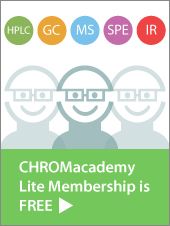HPLC Mobile Phases — 10 Bad Habits to Avoid
Check out this list of bad habits to avoid when using HPLC mobile phases.
1. Measuring the pH of the mobile phase after the organic has been added: pH meters are calibrated to give the correct pH readback in aqueous solution — the buffers you verify this with are aqueous. If you measure the pH with the organic added, the pH will be different to that of measuring before organic addition. However, the most important point is to be consistent. If you do always measure pH after the organic is added, make sure you state this in the method so that everyone does it the same way. It won’t be 100% accurate, but at least it will be consistent. This is probably more important than having the exact pH.
2. Not using a buffer: Buffers are present to control pH and resist a change in pH. Many other parts of method (for example, sample matrix, CO2 in air, source of water used for your mobile phase) can change the pH of the mobile phase causing shifts in retention, peak shape, and peak response. (Formic acid, TFA and so on are not buffers).3. Not using the buffer in its correct pH range: Each buffer salt has a two pH unit wide range over which it provides the optimal pH stability. Outside this window the salt is ineffective at resisting change in pH. Either use your buffer within the correct range or pick a buffer whose range covers the pH you require.
4. Adding buffer to organic: Mixing aqueous buffer into the organic phase carries a high risk of the buffer being precipitated — in many cases so finely that it may not be obvious it has happened. ALWAYS add the organic to the aqueous phase as this greatly reduces the risk of buffer precipitation.
5. Using the pump to mix gradients from 0%: Modern pumps are very effective at mixing mobile phases and degassing online, however not everyone has a high quality pump. Premix your A and B starting mix to a single solution that runs at 100% on line A. For example, prepare the starting mixture by mixing 950 ml Aqueous with 50 ml organic, then filter and degas. This reduces variability between HPLCs, reduces the risk of bubbles and precipitation in the system. Note: 95:5 mixed on the pump will not give the same retention time as 95:5 premixed in the bottle — you normally need to add a few more percent organic when premixing.
The complete article is available to CHROMacademy Lite and Premier members here >>
CHROMacademy Lite Membership is FREE and it only takes two minutes to register.
With a Lite Membership you are given access to:
∙ This month's webcast & tutorial
∙ Selected eLearning modules
∙ Featured CHROMacademy Content
∙ The CHROMacademy forum
Test drive CHROMacademy and Check out more great content available FREE to our Lite members »
Polysorbate Quantification and Degradation Analysis via LC and Charged Aerosol Detection
April 9th 2025Scientists from ThermoFisher Scientific published a review article in the Journal of Chromatography A that provided an overview of HPLC analysis using charged aerosol detection can help with polysorbate quantification.
Analyzing Vitamin K1 Levels in Vegetables Eaten by Warfarin Patients Using HPLC UV–vis
April 9th 2025Research conducted by the Universitas Padjadjaran (Sumedang, Indonesia) focused on the measurement of vitamin K1 in various vegetables (specifically lettuce, cabbage, napa cabbage, and spinach) that were ingested by patients using warfarin. High performance liquid chromatography (HPLC) equipped with an ultraviolet detector set at 245 nm was used as the analytical technique.
Removing Double-Stranded RNA Impurities Using Chromatography
April 8th 2025Researchers from Agency for Science, Technology and Research in Singapore recently published a review article exploring how chromatography can be used to remove double-stranded RNA impurities during mRNA therapeutics production.







